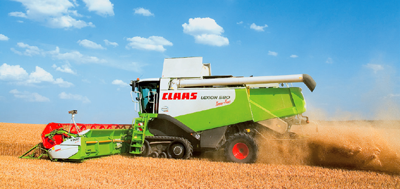 Crawler mechanisms are often required for agricultural machines. The crawler can only run properly under the correct tread tension. Simrit and their long-term partner, agricultural machine specialist Claas, have developed a new, robust, low-maintenance belt-tensioning cylinder with a long service life.
Crawler mechanisms are often required for agricultural machines. The crawler can only run properly under the correct tread tension. Simrit and their long-term partner, agricultural machine specialist Claas, have developed a new, robust, low-maintenance belt-tensioning cylinder with a long service life.
For continued high yields of grain and other crops, farmland must be treated with care. At the same time, only state-of-the-art agricultural machine technology can guarantee food supply at competitive prices.
The conflict between the retention of soil fertility and highly mechanized agricultural technology is increasing. Leading global manufacturers of agricultural machinery, such as the family-owned Claas company, are continually developing solutions for agricultural work machines that best combine soil health and harvest efficiency. This challenge cannot be met without precision vibration and sealing parts used in many components for combines and shredders.
Due to their tremendous weight, large wheel-driven harvesting machines cannot be used on wet soil—and not only with water crops such as rice. Crawlers like the current Claas TerraTrac are the best machines for all wet soil conditions. With the larger contact surface of the treads, heavy weights can be distributed over a wide “footprint.” This greatly reduces soil compaction, increasing farm productivity. Another advantage of TerraTrac crawlers is that they are also suitable for driving on roadways, saving time and money by eliminating the need for combine transport on a separate vehicle.
 Low maintenance effort
Low maintenance effort
Functional details are critical for crawlers and improper belt tension would render the equipment useless. The crawler belt must retain its tension over time without continuous maintenance, regardless of extreme temperature or humidity.
A new belt-tensioning cylinder was jointly developed with Simrit. Early solutions consisted of a common hydraulics cylinder and an additional hydraulics accumulator, as well as a large number of connecting hoses—all of which were attached separately to the crawler. The new Simrit/Claas solution has the accumulator integrated into the cylinder. The nitrogen-filled gas area exerts continuous pressure on the oil chamber which ensures that the crawler belt has the correct tension.
This integrated assembly completely dispenses with hoses, eliminating ever-present risk of hose failure from tearing, punctures, or other damage.
“The cylinder is designed in an integrated way, so that no dirt can enter, no hoses can tear, and the accumulator cannot break off. This makes the component more robust and lowers maintenance requirements,“ explains Mr. Obermeier-Hartmann, Crawler Project Manager at Claas.
High reliability
The cylinder has a gas pretension of 80 bar. To ensure that the crawler belt always has proper tension, the belt-tensioning cylinder is operated at 105 bar. The compact design also simplifies installation. The integrated assembly provides zero permeation and minimizes system inertia. Additionally, reaction time in the system was increased.
The integrated construction of the compact belt-tensioning cylinder also reduces costs by 50%.
“We have been working closely with Simrit for anything from the technical concept to the finished product for a very long time,” said Mr. Tomasevic, Claas Corporate Procurement Manager, in praise of the cooperation between the two family businesses. “We know that we always rely on Simrit’s team.”


If system inertia was minimized, why did reaction time increase? Was this deliberate, and it so, why was it done, and how was it accomplished? Reducing inertia and shortening / eliminating hoses ought to DECREASE response / reaction time, I would think… And usually, that’s a design goal anyway.